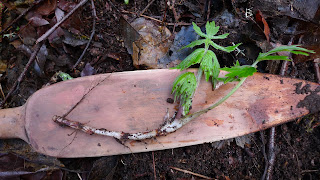 |
| Long rhizomes like this are near the surface and don't really require a digging stick. |
The Pacific Waterleaf (Hydrophyllum tenuipes) is flourishing
and, as promised earlier this week, I set out to experiment with this little
know wild green. In the Bellingham area,
I find Pacific Waterleaf growing on the north slopes of the Chuckanut Mountains
in loose wet soil under Bigleaf Maple (Acer
macrophyllum), Red Alder (Alnus rubra)
and Salmonberry (Rubus spectabilis). Waterleaf
is our first wild green of the season and rapidly grows from perennial roots
and rhizomes when the temperatures are warm enough to grow, during the period after the dark of winter and before the deciduous trees and shrubs above it leaf
out. I suspect Waterleaf may grow in areas with near surface groundwater flow, which may provide a thermal buffer against the effect of freezing weather on the early growth of the plants. Erna Gunther reported that the Cowlitz
broke up Waterleaf rhizomes and ate them so Katrina and I set to out harvest and eat some.
 |
| Radial rhizome growth around a perennial Waterleaf root stalk |
We found a healthy population of Waterleaf
growing under Bigleaf Maple with some 2” tall Stinging Nettles (Urtica dioica). Pealing back the Maple leaf litter and
detritus revealed the rhizomatous nature of Waterleaf colonies. Clumpy knots of long tapered roots send
radial rhizomes outward in search of new ground to colonize. We found that we could easily snap the
rhizomes away from the root clusters.
Rhizome growth appeared to be the longest on the colony edges, and some
individuals near the center had no discernible rhizome at all, which leads me
to suspect that a little disturbance of the colony matrix may actually
stimulate rhizome growth. We picked
several dozen rhizomes (with leaves) and rinsed them in a nearby stream. Back home, I noticed that the residual water
in my collecting bag had been stained red.
Perhaps the rhizomes could also be used as a dye plant.
 |
The raw rhizomes and a single leaf of
Pacific Waterleaf
|
 |
Green vegetables! Steamed rhizomes
(left) and leaves (right)
|
Note: Pacific Waterleaf is Red Listed in British Columbia.
